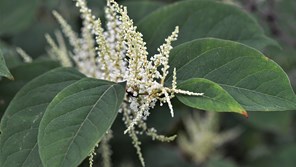Should I buy a house with Japanese knotweed?
5 minute read

Japanese knotweed can not only be extremely damaging to your home, it can also impact your home insurance too. If you are considering buying a house with this invasive pest growing nearby, here is some important information to consider

Get Home Insurance
Age Co helps homeowners over 50 find the right protection. We are 100% owned by Age UK and our profits go back to the charity.
What is Japanese knotweed?
Japanese knotweed has heart or spade-shaped leaves that grow in a zig-zag pattern along the stem. The stems that these leaves grow on are thick and look like bamboo canes. These individual canes can reach around seven feet tall. Japanese knotweed roots spread deep underground and grow through even the hardest of man-made materials, such as concrete. These roots find cracks in house foundations or paving and can make the issue much worse.
Since 2013, all house sellers that have Japanese knotweed growing on their property must declare this in their TA6 form. This form documents and details all information found during the conveyancing process.
What does Japanese knotweed do to a house?
This aggressive plant has been known to cause severe structural damage to homes. Its roots can push through walls and drains, up through paving or asphalt, and can make the foundations of your home weak and unstable. It’s even been known to grow up through people’s conservatories, coming through both the brick and the flooring. It can kill any other plants that are growing within its vicinity and is extremely difficult to get rid of.
The plant spreads so easily because of its stems. Otherwise known as rhizomes, this underground system can sprout new plants very quickly and effectively. When the plant is trimmed, these rhizomes can produce more shoots, making it spread faster.
Buying a house with Japanese knotweed present
If a Japanese knotweed plant from your property spreads to your neighbours, it’s your legal responsibility to have it removed. This is why, if you’re planning on buying a house with Japanese knotweed, you should consider how much it will cost to eradicate it.
On average, the cost of domestic knotweed removal in the UK is around £1,500 and £2,000. However, costs can go up to £20,000 if excavation, root barriers, or ongoing herbicide treatment is required.
Because of the removal costs involved, the value of the house is usually affected, and the property should be devalued accordingly.

How to check for Japanese knotweed
During February to March, the Japanese knotweed will be developing new buds. When these first appear, they’re red in colour. As they develop into shoots, the redness will turn a lighter colour. These shoots grow into hollow canes that resemble bamboo. They’re green in colour with purple flecks.
In Spring, approximately March to May, the leaves will be brown or yellow in colour. They will eventually turn a dark green in summer.
In Autumn, Japanese knotweed will produce lots of small white flowers. Depending on what time of year you are visiting the house, you can use the descriptions above to check your garden for the plant.
Be careful when you’re visiting a property during winter, as Japanese knotweed can die away, so it may not be as noticeable.
Alternatively, you could use Environet’s heat map to determine the areas of the UK where Japanese knotweed is worst. You can also see how many cases of it have been found in your local area.
Does house insurance cover Japanese knotweed?
If you’ve had Japanese knotweed for a while and it has caused subsidence previously, your cover may be declined. It’s possible that your insurance company may want to know more, such as:
- How long Japanese knotweed has been present
- Whether it is on your land or your neighbours’
- How far it is from the house
- Whether it has caused any damage to your home
When it comes to fixing the problem, most insurance companies won’t pay the cost of having Japanese knotweed removed. This can cost tens of thousands of pounds. They may, however, compensate you for any damage that has been caused by the shrub, such as subsidence or damage to the building.
Do I legally have to remove Japanese knotweed?
You do not legally have to remove Japanese knotweed from your land unless it’s causing a nuisance, but you can be prosecuted for causing it to spread into the wild.
For example: if you try to dispose of the plant by leaving it on the side of the road, you could face a fine, as it runs the risk of contaminating the local area.
It’s usually best to call in the professionals to remove it properly. Alternatively, you can reach out to the Environment Agency for more information.
Summary
Japanese knotweed is a notorious pest. If you’re considering purchasing a home and think it might be present, keep these key points in mind:
- If a buyer is aware of Japanese knotweed being present, they must legally declare this to you.
- Japanese knotweed can cause serious damage to your home, such as subsidence.
- If the plant spreads, which it can do very quickly, and damages a neighbour’s property, then you can be held financially responsible for the repairs.
- Removing Japanese knotweed can be expensive, and can cost as much as £20,000, if the problem requires excavation, root barriers, or ongoing herbicide treatment.
If you decide to go ahead and buy a property affected by Japanese knotweed, you could ask for the cost of treatment to be removed from the asking price.

Sign up to the Age Co Newsletter
Each month, our email newsletter delivers inspiring stories, practical guides to later life, plus the latest news about Age Co and the charitable work we support.
